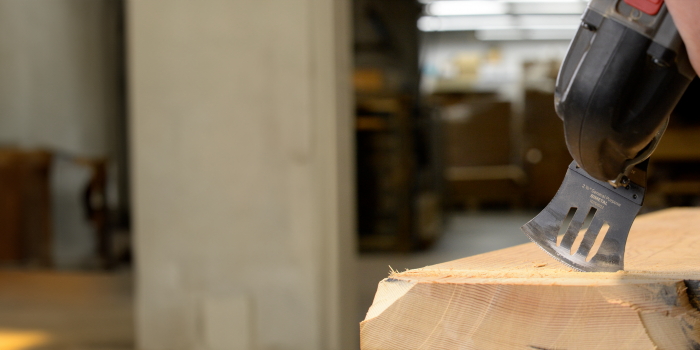When to use a diamond hole saw
2017/07/17
When to use a diamond hole saw
Diamond hole saws are designed to drill holes in glass, ceramics, porcelain, ceramic and porcelain tile, limestone, slate, marble, granite, stone, and fiberglass.
Diamond hole saw drilling technique
Balancing cutting speed, Drill Speed, Pressure and Lubrication
The cutting speed and life of a diamond hole saw are affected by the hardness and abrasiveness of the material plus the drill speed, pressure and lubrication. Experience with a specific material quickly allows a person to determine the optimum drill speed, pressure, and lubrication to obtain the fastest cutting speed with the least effect upon hole saw life and risk of heat fractures or breakage. However, when experience is lacking, it is best to start out with a very slow drill speed, very low pressure and lots of lubrication. This starting point reduces risks to a minimum and extends hole saw life considerably.
Recommended drill speeds
|
Diamond hole saws |
Recommended Drill Speed (rpm) |
||||
|---|---|---|---|---|---|
|
Material/Hole Saw Size |
1/2" |
1" |
2" |
3" |
4" |
|
Fiberglass |
1200 |
700 |
350 |
250 |
175 |
|
Glass, Ceramic & China |
800 |
500 |
250 |
160 |
125 |
|
Limestone & Marble Stone |
600 |
450 |
225 |
130 |
100 |
|
Ceramic Wall Tile |
600 |
450 |
225 |
130 |
100 |
|
Porcelain Wall Tile |
500 |
375 |
180 |
125 |
90 |
|
Porcelain Floor Tile |
500 |
375 |
180 |
125 |
90 |
|
Granite Stone |
400 |
300 |
150 |
100 |
75 |
(Not for use on concrete or masonry, or with hammer drills)
Recommended drill head pressure
|
Material |
Recommended Drill Head Pressure (lbs) |
|---|---|
|
Fiberglass |
10 to 15 lbs |
|
Limestone & Marble Stone |
12 to 18 lbs |
|
Glass, Ceramic & Porcelain China |
12 to 18 lbs |
|
Ceramic/Porcelain Wall Tile |
15 to 20 lbs |
|
Stone Style Porcelain Floor Tile |
18 to 30 lbs |
|
Granite Stone |
18 to 30 lbs |
Material hardness and abrasiveness
Materials have varying degrees of hardness and abrasiveness. Additionally, specific man-made and natural materials can differ greatly depending upon their exact physical compositions. For example, glass varies in hardness depending upon colour and type, since various metals and minerals are added to achieve the different types and colours. Glass also has differing degrees of "temper" depending upon the specific manufacturing methods used.
The hardness and abrasiveness of natural materials, such as stone, vary by type, but they also vary significantly within a specific type. Most stones are not pure - they are mixtures of various types of rock. Granite, for example, contains various combinations of primarily quartz, feldspar, black mica and hornblende. Therefore, a specific stone type such as granite or marble, will vary significantly in hardness and abrasiveness depending upon the exact mineral composition that varies by quarry location. For example, river sand is much less abrasive than quarry sand.
Below is a table of the hardness of various materials. The table uses the standard Knoop Hardness Scale (kg/mm2). The hardest known material is diamond, with a Knoop measurement of 7,000. Tungsten carbide, used in carbide hole saws, is the hardest natural material next to diamond. However, with a measurement of 2,000, tungsten carbide is only 30% as hard as diamond.
|
Material |
Knoop Hardness Scale |
|---|---|
|
Wood - Pine |
10 |
|
Copper |
120 |
|
Limestone |
125 - 150 |
|
Marble |
140 - 180 |
|
Slate |
140 - 250 |
|
Porcelain Fixtures & China |
400 - 500 |
|
Glass & Ceramic |
400 - 550 |
|
Ceramic Wall Tile |
450 - 550 |
|
Porcelain Wall Tile |
500 - 650 |
|
Porcelain Floor Tile |
500 - 650 |
|
Marble Style Porcelain Floor Tile |
500 - 650 |
|
Granite Style Porcelain Floor Tile |
500 - 650 |
|
Granite |
550 - 650 |
|
Quartz |
820 |
|
CommonTool Steel |
700 - 900 |
|
Tungsten Carbide |
2,000 |
|
Diamond |
7,000 |
Learn about how to prolong the life of your diamond hole saw
About Exchange-A-Blade diamond hole saws
Exchange-A-Blade diamond hole saws are market leaders in quality and value. They can be used to drill holes in glass, ceramics, porcelain, ceramic and porcelain tile, limestone, slate, marble, granite, stone, and fiberglass. They are available in a variety of sizes and come in a Professional Bronze Line and an Economy Green Line. All Exchange-A-Blade diamond hole saws come with a drilling template for accurate results.
Some content sourced at www.DiamondSure.com and www.diamond-drill-bit-and-tool.com.





.jpg)
